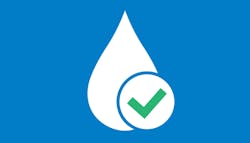Is your department meeting current water quality standards?
The quality and consistency of water used in Sterile Processing departments (SPDs) are critical. Evidence has shown the importance of proper water quality across all stages of instrument and endoscope reprocessing; however, water quality issues continue to present themselves and negatively impact the SPD (and Endoscopy department) in numerous ways.
While municipal water supplies are required to meet the U.S. Environmental Protection Agency’s (EPA’s) safe drinking water standards, surgical instrumentation and medical devices are frequently more sensitive to harmful contaminants and chemicals found in water today. Water systems within healthcare facilities are also comprised of complex distribution pathways that can become compromised over time. Additionally, water quality throughout the U.S. varies, and the impurities (i.e., bacteria and endotoxins, chemical additives, dissolved salts, high mineral contents, heavy metals, pathogens, and parasites) found in that water can have a profound impact on an organization’s ability to effectively manage the reprocessing of surgical instrumentation, flexible and rigid endoscopes, and probes.
Water impurities can decrease decontamination effectiveness, reduce the useful life expectancy of instrumentation and devices, and jeopardize patient health. This is why ANSI/AAMI ST91:2021 Comprehensive guide to flexible and semi-rigid endoscope processing in health care facilities, added to Section 4.3.11 Water quality). Note: Additional information on water quality can also be found in AAMI TIR34:2014/(R)2017 Water for the reprocessing of medical devices; however, TIR34 guidelines for water use in the SPD will soon be replaced with AAMI ST108 Water for the Processing of Reusable Medical Devices, which at the time of this writing was still under development. ST108 will emphasize proper water system design, monitoring, testing and maintenance as well as establish minimum requirements for the appropriate grades of water used at different points in the processing sequence.
To ensure that the correct water quality is used in each stage of processing, SP professionals should be familiar with— and have ready access to—the manufacturers’ written instructions for use (IFU) for all used and reprocessed items within their department. This includes surgical instrumentation, instrument and cart washing equipment, endoscopes and accessories, automatic endoscope reprocessors (AERs), chemicals, detergents and lubricants, and other products and supplies.
Diligent water monitoring essential
Quality water helps prolong the life of medical devices, facilitates effective functioning, and reduces the risk of medical device contamination. Every healthcare organization should continuously monitor and control the water supplied to the device processing departments/areas. Water testing should be performed whenever major repairs occur or changes to the water utility system are made.
When developing a water quality monitoring program, SP professionals should consider performing their own daily tests and documenting and trending those results over time. This may help SP leaders prevent problems proactively. It is also prudent to compare test results with the organization’s Facilities department to ensure the results match. Again, SP leaders and technicians should carefully review all IFU for detergents, cleaning products, degreasers, lubricants and other chemicals used in the department, and they should validate water quality requirements for automated and manual cleaning equipment, instrumentation, endoscopes, probes, and other medical devices reprocessed within the department.
When implementing a water treatment process, consider the following:
- Working with the Facilities department to implement a practical monitoring program
- Developing a routine water quality monitoring process
- Test water entering the facility
- Test water entering the SPD
- Compare the tests and rectifying discrepancies
- Upgrading water purifying systems, as needed, until water quality standards are met or exceed industry standards
- Documenting your work, test results and actions taken to rectify problems
Conclusion
There is no one-size-fits all approach when dealing with water quality issues within healthcare facilities. The key having SP leaders collaborate and engage with key stakeholders that help put the necessary controls in place to handle any water situation that arises.
Today’s SP leaders must understand the common water treatment options and methods used to monitor these systems—now and in the future—and they should collaborate with administrative personnel to implement adequate procedures that will comply with the latest standards. Doing so will allow SP professionals to spend less time worrying about water quality and more time focusing on processing items for patient use.
About the Author

David Taylor
Principal, Resolute Advisory Group LLC
David L. Taylor, MSN, RN, CNOR is an independent hospital and ambulatory surgery center consultant and the principal of Resolute Advisory Group LLC, in San Antonio, Texas.
